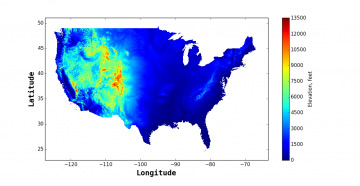Analysis Reveals Impact of Road Grade on Vehicle Energy Use

A color plot showing elevation values for the contiguous United States. Source data derived from the USGS digital elevation model, which features validated elevation data at 10-meter intervals—resulting in about 800 billion data points.
Understanding the power demands of modern automobiles is essential for designing increasingly efficient powertrains. In recent years, the advent of ubiquitous global positioning systems has made large-scale data collection of vehicle speed and associated power demand a reality. While the availability of such real-world data has improved industry’s understanding of in-use vehicle power demands, little attention has been paid to the incremental energy requirements imposed by road grade—until now.
With funding from the U.S. Department of Energy’s Vehicle Technologies Office, a team of engineers from the National Renewable Energy Laboratory performed an analysis quantifying the incremental efficiency impacts of road grade by appending high-fidelity elevation profiles to GPS speed traces. This in-depth study employed nationwide elevation data from a U.S. Geological Survey digital elevation model as well as detailed GPS data from NREL's Transportation Secure Data Center with drive cycles from more than 250,000 unique trips in various metropolitan areas across the country.
Using NREL’s Future Automotive Systems Technology Simulator (FASTSim), the team performed vehicle powertrain simulations with and without road grade for five vehicle models—conventional, hybrid, and all-electric midsized cars and conventional and hybrid SUVs.
Aggregate results of the study suggest that, on average, road grade could be responsible for 1%–3% of fuel use in light-duty automobiles. Variation from the average can be quite significant for individual trips, with many uphill trips using as much as 15%–40% more fuel and many downhill trips using as much as 10%–35% less fuel than if grade was not considered. In particular, the simulated hybrid and all-electric vehicles experienced greater variation in fuel penalty on a percentage basis due to their nominally lower energy consumption rates.
On the other hand, the simulated conventional vehicles experienced average grade penalties 25%–73% greater than their hybrid and all-electric counterparts. These differences are likely due to the regenerative braking systems in hybrid and all-electric vehicles and their ability to eliminate idle fuel use during low-power downhill driving.
This previously non-existent data is expected to aid in the design of powertrain components by providing anticipated operating envelopes based on real-world data inclusive of road grade.
For more information, refer to the conference paper—Contribution of Road Grade to the Energy Use of Modern Automobiles across Large Datasets of Real-World Drive Cycles.
